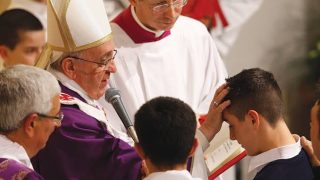
THE LORD HAS RISEN FROM THE DEAD: CATECHESIS ON THE RESURRECTION.
HOMILY FOR EASTER SUNDAY. Readings: Acts 10:34.37-43; Psalm 118; Colossians 3:1-4 and John 20:1-9.
We begin our Mass by lighting the Easter/paschal candle (presence of the Light of the world), the light of Christ who dispels the darkness of our hearts and our minds. We are called to be Light and to live in the Light, which is Christ. That is why we traditionally light up our candles from the paschal candle. The letters, numbers and artwork we see on the paschal candle are significant. They symbolize Christ yesterday and today, the beginning and the end, the Alpha and the Omega, to Him belongs all time and eternity, glory and power, for centuries without end.
Today we celebrate with joy the Sunday of the Lord’s resurrection. In the first reading from Acts of the Apostles, Peter presents a catechesis that summarizes the life of Christ (v. 39-41), that He is a Jew, anointed for the mission, he was killed by the authorities, but God raised him up, and he is now present in the life of the community and the Church. He is present among us as the new Light that comes to enlighten all nations that are in darkness. That is why we receive the candles on the day of our baptism and the minister says: receive the Light of Christ.
Paul in the second reading in his letter to the Colossians, presents the eschatology of the baptized who live in hope of the resurrection. He said, “When Christ who is our life appears, then you also will appear with him in glory.” To appear with Christ in glory gives an indication of the resurrection. We see in the Gospel of John the first person who discovered that the Lord had risen. Mary Magdalene, who went to visit Jesus’ tomb but did not find him. Though frightened by what had happened, she was willing to announce the resurrection of Christ to his disciples.
Analyzing this reading full of signs about JOHN the beloved and PETER, it is interesting to note that Peter went to the empty tomb and did not believe, despite the testimony of the community. Thomas too did not believe, he went as far as demanding proof of the resurrection. However, it was John the beloved disciple who went in after Peter, saw the empty tomb and believed (v.8). Mary Magdalene also upon hearing the word of Jesus, believed in him. That is why chapter 20 is considered as catechesis on the resurrection of Christ”.
Mary Magdalene is a symbolic figure of the community with no perspective of faith. She went to the empty tomb and realized that Christ was no more there. With this knowledge, she ran to meet the disciples. When she found them, she told them about “Theft of the body” not resurrection. She said, “They have taken the Lord out of the tomb, and we do not know where they have laid him.” The two disciples ran off, the beloved disciple arrived first but did not go in. Peter arrived later, went in but did not believe, while the beloved disciple went in and believed he had risen.
Interesting is the linen cloths and the napkin rolled up in a place. In Jewish culture, whoever finishes his meal, tidies up his napkin. Jesus, leaving the linen cloths lying on the floor, would mean that he had not finished yet. Soon, he would encounter his disciples, ascend into heaven (when the Easter candle would be put out), and will send the Holy Spirit who will remain with the Church till the end of time. Today’s liturgy affirms the mystery of our faith that Christ has died, Christ is risen and Christ will come again. Hence, we are encouraged to be witnesses to the Risen Lord as the Easter celebration inflames our joy and hope. May the light of the Risen Lord dispel every darkness in our hearts through Christ our Lord. Amen!
Happy Easter!
Fr. Ken Dogbo, OSJ










